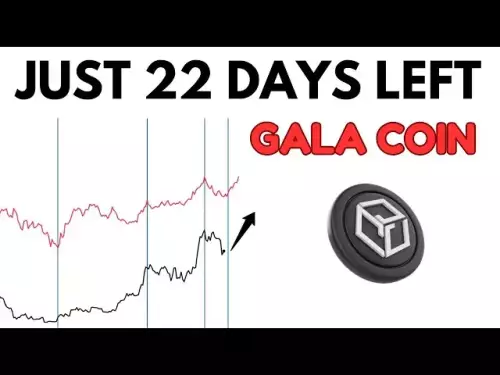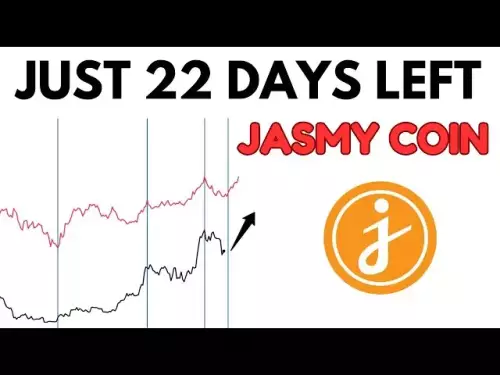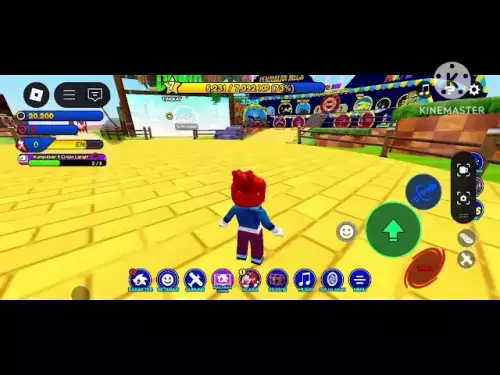-
 Bitcoin
Bitcoin $111700
-2.81% -
 Ethereum
Ethereum $4603
-3.72% -
 XRP
XRP $2.946
-2.80% -
 Tether USDt
Tether USDt $0.9998
0.02% -
 BNB
BNB $859.1
-1.16% -
 Solana
Solana $199.0
-4.50% -
 USDC
USDC $0.9999
0.01% -
 TRON
TRON $0.3517
-3.87% -
 Dogecoin
Dogecoin $0.2206
-5.06% -
 Cardano
Cardano $0.8705
-3.56% -
 Chainlink
Chainlink $24.97
-2.00% -
 Hyperliquid
Hyperliquid $45.27
2.41% -
 Stellar
Stellar $0.3921
-4.15% -
 Sui
Sui $3.479
-5.69% -
 Ethena USDe
Ethena USDe $1.000
0.00% -
 Bitcoin Cash
Bitcoin Cash $565.6
-4.80% -
 Avalanche
Avalanche $24.28
-4.82% -
 Hedera
Hedera $0.2377
-4.01% -
 UNUS SED LEO
UNUS SED LEO $9.508
-1.05% -
 Litecoin
Litecoin $112.6
-6.16% -
 Toncoin
Toncoin $3.215
-4.04% -
 Shiba Inu
Shiba Inu $0.00001244
-3.67% -
 Uniswap
Uniswap $10.28
-7.32% -
 Polkadot
Polkadot $3.909
-4.34% -
 Dai
Dai $0.9999
0.00% -
 Cronos
Cronos $0.1583
-1.98% -
 Bitget Token
Bitget Token $4.533
-3.76% -
 Monero
Monero $276.0
2.59% -
 Aave
Aave $329.3
-5.93% -
 Pepe
Pepe $0.00001031
-5.69%
How does the KDJ indicator compare to using moving averages?
The KDJ indicator identifies overbought/oversold levels for early reversal signals, while moving averages confirm trend direction—combining both improves trading accuracy in volatile crypto markets.
Aug 07, 2025 at 11:02 am
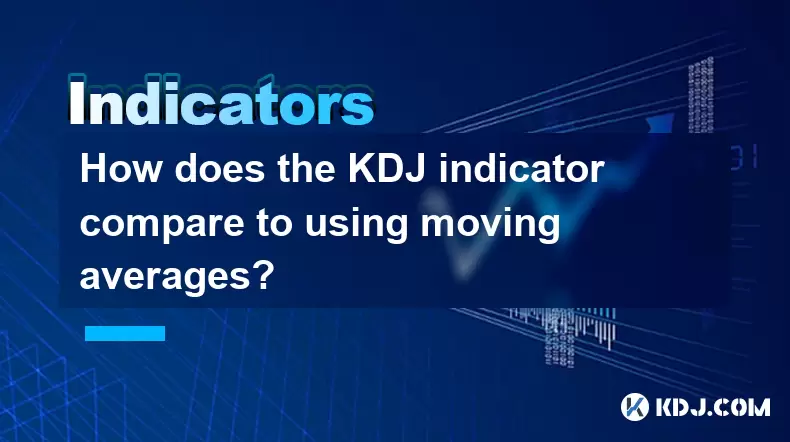
Understanding the KDJ Indicator and Its Components
The KDJ indicator is a momentum oscillator derived from the Stochastic Oscillator, widely used in cryptocurrency trading to identify overbought and oversold conditions. It consists of three lines: %K, %D, and %J. The %K line is the fastest and reflects the current closing price relative to the price range over a specific period, typically 9 candles. The %D line is a moving average of %K, acting as a signal line. The %J line represents a divergence of %K from %D, calculated as 3×%K – 2×%D, making it the most sensitive to price changes.
Traders interpret crossovers between %K and %D as potential buy or sell signals. When %K crosses above %D in the oversold region (below 20), it may signal a bullish reversal. Conversely, when %K crosses below %D in the overbought region (above 80), it may indicate a bearish reversal. The J line can also signal extremes; values above 100 suggest overbought conditions, while values below 0 suggest oversold conditions.
Because the KDJ reacts quickly to price movements, it is particularly useful in volatile cryptocurrency markets where rapid price swings are common. However, this sensitivity can also lead to false signals during sideways or choppy market phases.
How Moving Averages Function in Crypto Trading
Moving averages (MAs) are trend-following indicators that smooth out price data over a specified number of periods. The most commonly used types are the Simple Moving Average (SMA) and the Exponential Moving Average (EMA). The SMA calculates the average closing price over a set number of periods, while the EMA gives more weight to recent prices, making it more responsive to new information.
In cryptocurrency trading, moving averages help identify the direction of the trend. For instance, if the price is consistently above a 50-day SMA, the trend is considered bullish. Crossovers between short-term and long-term MAs, such as the 50-day and 200-day MA, are used to generate trading signals. A "golden cross" occurs when the 50-day MA crosses above the 200-day MA, suggesting a potential uptrend. A "death cross" happens when the 50-day MA falls below the 200-day MA, indicating a possible downtrend.
Moving averages are also used to determine dynamic support and resistance levels. In an uptrend, the MA can act as support; in a downtrend, it can act as resistance. Because MAs lag price action, they are less prone to false signals than oscillators like the KDJ but may delay entry or exit points.
Differences in Signal Generation: KDJ vs. Moving Averages
The KDJ indicator generates signals based on momentum and price extremes, while moving averages respond to directional trends and price crossovers. This fundamental difference affects how traders use them.
- The KDJ provides early reversal signals by detecting when an asset is overbought or oversold. For example, if Bitcoin’s price has risen sharply and the KDJ %K line drops below %D while above 80, it may suggest a pullback is imminent.
- Moving averages confirm trend direction and generate signals only after a trend has been established. If Ethereum’s price crosses above its 20-day EMA, it may confirm upward momentum, but this occurs after the move has started.
Because the KDJ is mean-reverting, it assumes prices will return to average levels after extreme moves. Moving averages, on the other hand, are trend-continuation tools, assuming that prices will keep moving in the same direction until the trend breaks.
Using KDJ and Moving Averages Together
Combining the KDJ indicator with moving averages can enhance trading accuracy by filtering signals and reducing false entries. Here’s how to integrate them effectively:
- Wait for the price to be above a key moving average, such as the 50-day EMA, indicating an uptrend. Then look for a KDJ crossover in the oversold zone as a potential buy signal. This confirms both trend alignment and momentum support.
- Conversely, if the price is below the 200-day SMA, indicating a bearish trend, a KDJ %K crossing below %D in the overbought region could reinforce a shorting opportunity.
- Use the J line to detect divergences. If the price makes a higher high but the J line makes a lower high, it may signal weakening momentum, even if the moving average still shows an uptrend.
This combination allows traders to enter trades with higher probability by aligning momentum signals with trend direction.
Step-by-Step Setup on a Crypto Trading Platform
To apply both indicators on a cryptocurrency trading chart, follow these steps:
- Open your trading platform (e.g., Binance, TradingView).
- Select the cryptocurrency pair you want to analyze (e.g., BTC/USDT).
- Click on the "Indicators" button and search for "Stochastic" or "KDJ". Add it to the chart with default settings (9,3,3).
- Adjust the KDJ parameters if needed: set %K period to 9, %D smoothing to 3, and J multiplier to 3.
- Next, add a moving average: search for "Moving Average", choose EMA, set period to 50, and color it blue.
- Add a second MA: use SMA with period 200 and color it red.
- Observe how the price interacts with the MAs and how the KDJ lines move in relation to the 20 and 80 levels.
- Enable alerts for KDJ crossovers and MA crossovers to receive real-time notifications.
Ensure the chart timeframe matches your strategy—shorter timeframes like 15-minute charts suit KDJ’s sensitivity, while daily charts work better for moving average trends.
Volatility and Timeframe Considerations
Cryptocurrency markets are highly volatile, which affects how both indicators perform. The KDJ indicator can produce numerous false signals during high volatility, especially on lower timeframes like 5-minute or 15-minute charts. During strong trending moves, the KDJ may remain in overbought or oversold territory for extended periods, leading to premature entries.
In contrast, moving averages perform better in trending markets but can whipsaw in ranging conditions. For example, during a sideways Bitcoin consolidation, the price may repeatedly cross above and below the 50-day EMA, generating multiple false signals.
To mitigate this:
- Use higher timeframes (4-hour or daily) to reduce noise when applying KDJ.
- Apply multiple moving averages (e.g., 20, 50, 200) to confirm trend strength.
- Combine with volume indicators to validate KDJ signals.
Frequently Asked Questions
Can the KDJ indicator be used on all cryptocurrencies?
Yes, the KDJ indicator can be applied to any cryptocurrency trading pair, including Bitcoin, Ethereum, and altcoins. However, its effectiveness varies based on liquidity and volatility. Highly volatile or low-volume coins may produce unreliable signals due to erratic price movements.
What are the best settings for KDJ in crypto trading?
The standard setting is (9,3,3), but traders often adjust it based on timeframe. For 1-hour charts, (14,3,3) may reduce noise. For scalping on 5-minute charts, (5,3,3) increases sensitivity. Always backtest settings on historical data before live trading.
Do moving averages work well in bear markets?
Yes, moving averages can identify downtrends effectively. When the price stays below the 200-day SMA and lower MAs, it confirms bearish momentum. Short trades triggered by price rejections at the MA can be high-probability setups.
Is it better to rely on KDJ or moving averages alone?
Relying on a single indicator increases risk. The KDJ excels in range-bound markets, while moving averages perform better in trending environments. Using both together improves signal reliability by combining momentum and trend analysis.
Disclaimer:info@kdj.com
The information provided is not trading advice. kdj.com does not assume any responsibility for any investments made based on the information provided in this article. Cryptocurrencies are highly volatile and it is highly recommended that you invest with caution after thorough research!
If you believe that the content used on this website infringes your copyright, please contact us immediately (info@kdj.com) and we will delete it promptly.
- Cold Wallet's CWT: The Undervalued Crypto Utility Token Primed for Post-ETF Success
- 2025-08-25 18:45:19
- Adele, Instagram, and Crypto Scams: A New York Minute on Celebrity Hacks
- 2025-08-25 19:05:12
- Mantle, Hedera, and BlockchainFX: Decoding the Hype
- 2025-08-25 19:25:14
- Token Unlocks & Crypto Markets: Decoding the $620M Jolt
- 2025-08-25 17:25:13
- Super Apps and Crypto UX: A New Era for User Experience
- 2025-08-25 17:30:12
- Zora Price Surge Fueled by Coinbase CEO: ATH in Sight?
- 2025-08-25 16:45:19
Related knowledge
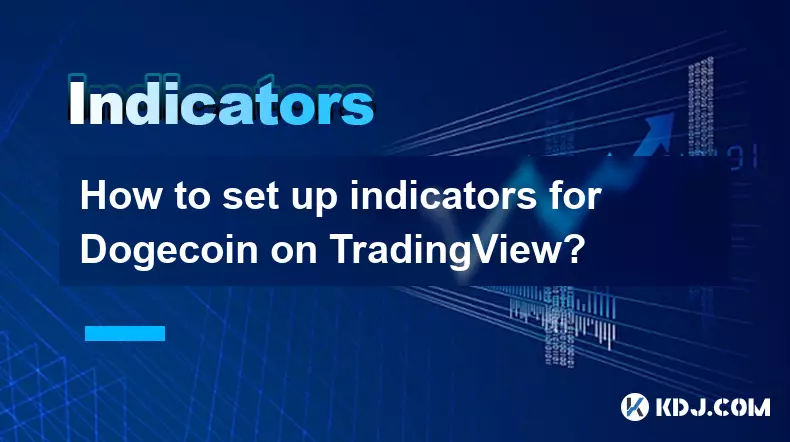
How to set up indicators for Dogecoin on TradingView?
Aug 25,2025 at 04:23pm
Understanding Dogecoin and TradingView1. Dogecoin, initially created as a meme-based cryptocurrency, has evolved into a widely traded digital asset. I...

What does it mean when the +DI and -DI cross frequently in the DMI indicator but the ADX is flattening?
Aug 11,2025 at 03:15am
Understanding the DMI Indicator ComponentsThe Directional Movement Index (DMI) is a technical analysis tool composed of three lines: the +DI (Positive...

What does the sudden appearance of a "dark cloud cover" candlestick pattern during an uptrend indicate?
Aug 13,2025 at 11:35am
Understanding the 'Dark Cloud Cover' Candlestick PatternThe dark cloud cover is a bearish reversal pattern in technical analysis that typically appear...

What does it mean when the moving average, MACD, and RSI all send buy signals simultaneously?
Aug 11,2025 at 01:42pm
Understanding the Convergence of Technical IndicatorsWhen the moving average, MACD, and RSI all generate buy signals at the same time, traders interpr...

What does it mean when both the KDJ indicator and the RSI show overbought signals simultaneously?
Aug 13,2025 at 11:35am
Understanding the KDJ Indicator in Cryptocurrency TradingThe KDJ indicator is a momentum oscillator derived from the Stochastic Oscillator, widely use...

What does it mean when the price is trading above the SAR indicator but the red dots are densely packed?
Aug 09,2025 at 11:49pm
Understanding the SAR Indicator and Its Visual SignalsThe SAR (Parabolic Stop and Reverse) indicator is a technical analysis tool used primarily to de...

How to set up indicators for Dogecoin on TradingView?
Aug 25,2025 at 04:23pm
Understanding Dogecoin and TradingView1. Dogecoin, initially created as a meme-based cryptocurrency, has evolved into a widely traded digital asset. I...

What does it mean when the +DI and -DI cross frequently in the DMI indicator but the ADX is flattening?
Aug 11,2025 at 03:15am
Understanding the DMI Indicator ComponentsThe Directional Movement Index (DMI) is a technical analysis tool composed of three lines: the +DI (Positive...

What does the sudden appearance of a "dark cloud cover" candlestick pattern during an uptrend indicate?
Aug 13,2025 at 11:35am
Understanding the 'Dark Cloud Cover' Candlestick PatternThe dark cloud cover is a bearish reversal pattern in technical analysis that typically appear...

What does it mean when the moving average, MACD, and RSI all send buy signals simultaneously?
Aug 11,2025 at 01:42pm
Understanding the Convergence of Technical IndicatorsWhen the moving average, MACD, and RSI all generate buy signals at the same time, traders interpr...

What does it mean when both the KDJ indicator and the RSI show overbought signals simultaneously?
Aug 13,2025 at 11:35am
Understanding the KDJ Indicator in Cryptocurrency TradingThe KDJ indicator is a momentum oscillator derived from the Stochastic Oscillator, widely use...

What does it mean when the price is trading above the SAR indicator but the red dots are densely packed?
Aug 09,2025 at 11:49pm
Understanding the SAR Indicator and Its Visual SignalsThe SAR (Parabolic Stop and Reverse) indicator is a technical analysis tool used primarily to de...
See all articles





















